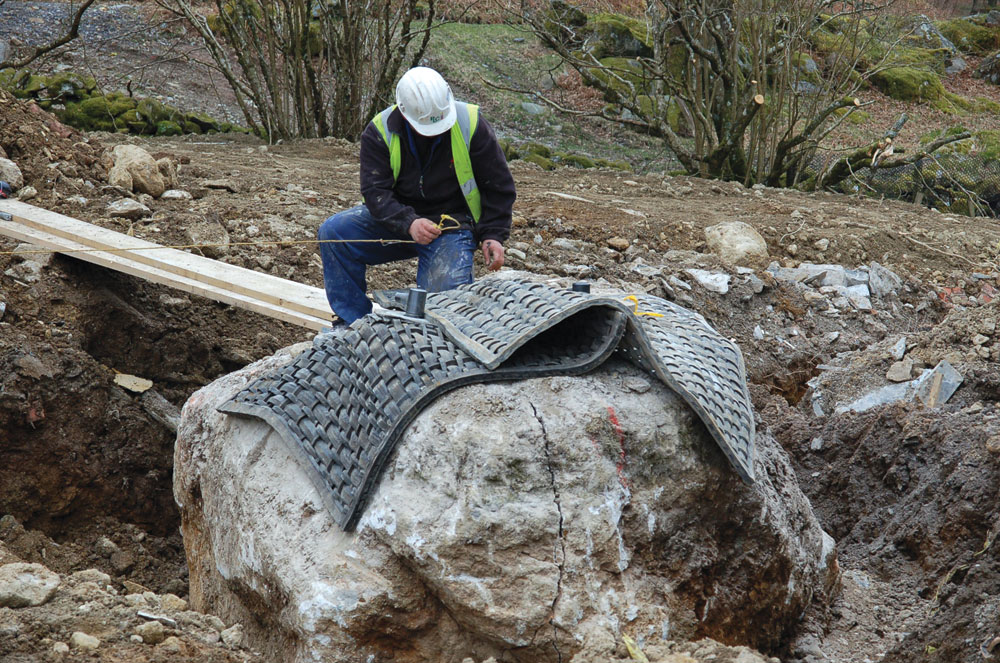Boulder Buster

The better solution in rock breaking
The Boulder Buster is a compact and portable piece of standby equipment that provides a cost-effective and convenient way to safely break rocks and concrete in situations where conventional explosives are prohibited or inappropriate. The secret of the tool is in the controlled use of propellant energy as a power source. Cartridges of propellant are used to direct a pressure impulse into a drill hole filled with water. The ensuing pressure wave forces the water into existing micro-cracks in the material resulting in controlled tensile fracturing.
In use, the device is placed in a water- filled drill hole, held down with a flexible mat and mechanically initiated by means of a short lanyard. It is safe to use in close quarters as fly-rock is negligible, noxious fumes are non-existent and ground vibrations are minimal. In many situations, it allows simple breaking operations to be carried out without the difficulties and restrictions placed on conventional explosive use in crowded areas.
What it does
Essentially, the Boulder Buster can do anything a small-diameter blasthole charged with conventional explosives can do, but in a safer and much more controlled manner. The biggest difference is that the Boulder Buster splits the material rather than shattering it, using the energy contained in one or more shotgun shell-sized cartridges. These cartridges contain a modified chemical compound similar to rifle powder that burns (deflagrates) at a controlled rate, rather than exploding instantly as in the case of a conventional explosive. They are, therefore, classified as power-tool cartridges and not as explosives.
How is it different?
The device works using a principle known as hydro-fracturing. A cartridge is initiated creating a hydrostatic pressure wave in a column of water. This action generates a hydraulic impulse that typically has a duration of 3 to 5 milliseconds. During this time, cracks are created and expanded as the water/gas mixture penetrates and wedges apart the material. In conventional breaking with a chemical explosive, the energy developed by the reaction (the explosion) continues until the chemical products are consumed, even after its work is finished. If there is more energy available than actually needed, the continued gas expansion can result in excessive shattering, movement and throw.
With the Boulder Buster technology, the difference is that, upon initiation, all the propellant’s energy is transferred completely to the column of water in the drill hole. Because water cannot be compressed, it is driven and wedged like a solid into pre-existing micro-cracks in the rock. Once the material splits, the remaining pressure in the hole is vented and, therefore, diminished to such a degree that very little energy is available for the creation of fly-rock. This results in splitting and breaking without excessive fragmentation, scatter or noise.
Some benefits
Because the system breaks material with a negligible amount of fly-rock, no noxious fumes and almost no ground vibration, it allows rock to be broken in the most restrictive circumstances. For example, it can be used in very tight excavations where explosives are not allowed or are inappropriate, and in situations where it is not possible to use hydraulic hammers. Moreover, there are no unduly restrictive regulations affecting the storage, transportation or use of the tool and/or the cartridges.
Who can use it?
Any worker with a good grasp of the safety aspects of the tool and an understanding of its basic principles can operate it. An explosives user’s license is not required as the cartridges fall into the same category as nail-gun cartridges. Although classed as a hazardous material (Explosive 1.4S - UN0323), they are judged to present a minimum hazard during transport and storage. The cartridges and the tool can, therefore, be shipped within the UK by common carrier.
Basic use
The application of this technology is straightforward; simply drill a 28–32mm diameter hole, fill it with water, drop one or more booster cartridges in the water, place the device in the hole and lay the flexible mat over it, load the primer cartridge and set it off mechanically by pulling a lanyard from a safe distance of at least 7m. It is not necessary to evacuate personnel or shut down other activities in the area when using the tool (15m is an adequate safety clearance).
How to use
The tool can be used in a number of different ways, with the type of work that needs to be done dictating the proper method of use. Usually, procedures involve either breaking or splitting an entire unconfined mass, such as an exposed boulder sitting on the surface, or precisely breaking pieces from a confined or partly covered object in order to achieve a particular end, such as completing an excavation or opening a trench.
When an unconfined rock needs to be split into several pieces, a hole should be drilled to a point just past the center of the mass. If the size of the entire mass cannot be determined, such as when bedrock or large rocks are encountered in an excavation, the hole needs to be positioned and drilled deep enough to ensure that a correctly sized piece of material will be broken or split from the edge of the rock when the device is fired. Depending upon the breakability of the material, a hole can be drilled anywhere from 460mm to as much as 1,200mm in from the edge or face.
Booster cartridges
Booster cartridges are available for larger boulders and rocks. The in-hole boosters allow the user to adjust the amount of energy to match the mass or toughness of the material to be broken. The booster cartridge has the shape of an 8-gauge shotgun shell and contains 15 grams of propellant. Up to a maximum of three booster cartridges can be dropped into the water-filled hole prior to inserting the breech body. It is recommended that a thickening agent or gel be used to space the cartridges evenly along the length of a deep hole for better results. In situations where the rock or boulders are porous or cracked and will not hold water, the gel has proved to be an effective carrier of the shock impulse.
For further details or a demonstration, contact Garry Roberts via the form below.
Advantages
- Safe and simple to operate
- Energy efficient
- No damage to structures and equipment
- Very low concussion
- Insignificant toxic gases
- Low-velocity fly-rock and very little scatter
- No blasting license required
- Lightweight and compact
- Cost-effective
Applications
- Secondary breaking in quarries and mines
- Dimension stone dressing and sizing
- Civil construction
- Demolition
- Site clearance
- Trench digging


Do you sell bulder busters?
Any info would be much apperiated
Can contact via email at deanlawless@y7mail.com
Cheers
Dean
- Reply
Permalink